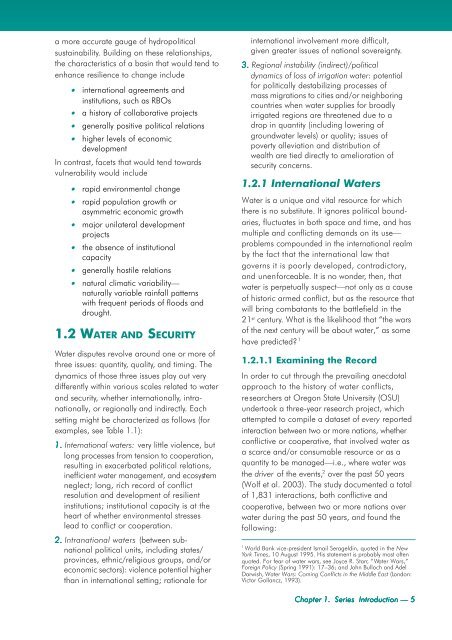Latin America; in English (pdf) - Transboundary Freshwater Dispute ...
Latin America; in English (pdf) - Transboundary Freshwater Dispute ...
Latin America; in English (pdf) - Transboundary Freshwater Dispute ...
Create successful ePaper yourself
Turn your PDF publications into a flip-book with our unique Google optimized e-Paper software.
a more accurate gauge of hydropolitical<br />
susta<strong>in</strong>ability. Build<strong>in</strong>g on these relationships,<br />
the characteristics of a bas<strong>in</strong> that would tend to<br />
enhance resilience to change <strong>in</strong>clude<br />
• <strong>in</strong>ternational agreements and<br />
<strong>in</strong>stitutions, such as RBOs<br />
• a history of collaborative projects<br />
• generally positive political relations<br />
• higher levels of economic<br />
development<br />
In contrast, facets that would tend towards<br />
vulnerability would <strong>in</strong>clude<br />
• rapid environmental change<br />
• rapid population growth or<br />
asymmetric economic growth<br />
• major unilateral development<br />
projects<br />
• the absence of <strong>in</strong>stitutional<br />
capacity<br />
• generally hostile relations<br />
• natural climatic variability—<br />
naturally variable ra<strong>in</strong>fall patterns<br />
with frequent periods of floods and<br />
drought.<br />
1.2 WATER AND SECURITY<br />
Water disputes revolve around one or more of<br />
three issues: quantity, quality, and tim<strong>in</strong>g. The<br />
dynamics of those three issues play out very<br />
differently with<strong>in</strong> various scales related to water<br />
and security, whether <strong>in</strong>ternationally, <strong>in</strong>tranationally,<br />
or regionally and <strong>in</strong>directly. Each<br />
sett<strong>in</strong>g might be characterized as follows (for<br />
examples, see Table 1.1):<br />
1. International waters: very little violence, but<br />
long processes from tension to cooperation,<br />
result<strong>in</strong>g <strong>in</strong> exacerbated political relations,<br />
<strong>in</strong>efficient water management, and ecosystem<br />
neglect; long, rich record of conflict<br />
resolution and development of resilient<br />
<strong>in</strong>stitutions; <strong>in</strong>stitutional capacity is at the<br />
heart of whether environmental stresses<br />
lead to conflict or cooperation.<br />
2. Intranational waters (between subnational<br />
political units, <strong>in</strong>clud<strong>in</strong>g states/<br />
prov<strong>in</strong>ces, ethnic/religious groups, and/or<br />
economic sectors): violence potential higher<br />
than <strong>in</strong> <strong>in</strong>ternational sett<strong>in</strong>g; rationale for<br />
<strong>in</strong>ternational <strong>in</strong>volvement more difficult,<br />
given greater issues of national sovereignty.<br />
3. Regional <strong>in</strong>stability (<strong>in</strong>direct)/political<br />
dynamics of loss of irrigation water: potential<br />
for politically destabiliz<strong>in</strong>g processes of<br />
mass migrations to cities and/or neighbor<strong>in</strong>g<br />
countries when water supplies for broadly<br />
irrigated regions are threatened due to a<br />
drop <strong>in</strong> quantity (<strong>in</strong>clud<strong>in</strong>g lower<strong>in</strong>g of<br />
groundwater levels) or quality; issues of<br />
poverty alleviation and distribution of<br />
wealth are tied directly to amelioration of<br />
security concerns.<br />
1.2.1 International Waters<br />
Water is a unique and vital resource for which<br />
there is no substitute. It ignores political boundaries,<br />
fluctuates <strong>in</strong> both space and time, and has<br />
multiple and conflict<strong>in</strong>g demands on its use—<br />
problems compounded <strong>in</strong> the <strong>in</strong>ternational realm<br />
by the fact that the <strong>in</strong>ternational law that<br />
governs it is poorly developed, contradictory,<br />
and unenforceable. It is no wonder, then, that<br />
water is perpetually suspect—not only as a cause<br />
of historic armed conflict, but as the resource that<br />
will br<strong>in</strong>g combatants to the battlefield <strong>in</strong> the<br />
21 st century. What is the likelihood that “the wars<br />
of the next century will be about water,” as some<br />
have predicted? 1<br />
1.2.1.1 Exam<strong>in</strong><strong>in</strong>g the Record<br />
In order to cut through the prevail<strong>in</strong>g anecdotal<br />
approach to the history of water conflicts,<br />
researchers at Oregon State University (OSU)<br />
undertook a three-year research project, which<br />
attempted to compile a dataset of every reported<br />
<strong>in</strong>teraction between two or more nations, whether<br />
conflictive or cooperative, that <strong>in</strong>volved water as<br />
a scarce and/or consumable resource or as a<br />
quantity to be managed—i.e., where water was<br />
the driver of the events, 2 over the past 50 years<br />
(Wolf et al. 2003). The study documented a total<br />
of 1,831 <strong>in</strong>teractions, both conflictive and<br />
cooperative, between two or more nations over<br />
water dur<strong>in</strong>g the past 50 years, and found the<br />
follow<strong>in</strong>g:<br />
1<br />
World Bank vice-president Ismail Serageld<strong>in</strong>, quoted <strong>in</strong> the New<br />
York Times, 10 August 1995. His statement is probably most often<br />
quoted. For fear of water wars, see Joyce R. Starr, “ Water Wars,”<br />
Foreign Policy (Spr<strong>in</strong>g 1991): 17–36; and John Bulloch and Adel<br />
Darwish, Water Wars: Com<strong>in</strong>g Conflicts <strong>in</strong> the Middle East (London:<br />
Victor Gollancz, 1993).<br />
Chapter 1. Series Introduction — 5
















